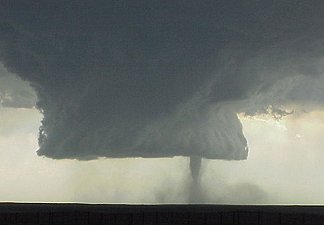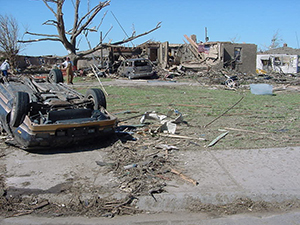TORNADO PREPAREDNESS
Tornadoes
 The most destructive and devastating product of a thunderstorm, tornadoes are characterized by a funnel-shaped cloud, which forms at the bottom of a wall cloud and reaches to the ground. Tornadoes are more often than not, accompanied by lightning, heavy rain and hail. In an average year, the United States reports 800 tornadoes resulting in 80 deaths and 1,500 injuries.
The most destructive and devastating product of a thunderstorm, tornadoes are characterized by a funnel-shaped cloud, which forms at the bottom of a wall cloud and reaches to the ground. Tornadoes are more often than not, accompanied by lightning, heavy rain and hail. In an average year, the United States reports 800 tornadoes resulting in 80 deaths and 1,500 injuries.
While tornadoes can occur all year, they are most common in Nebraska during spring and early summer, where they develop along dry lines. Dry lines separate very warm, moist air to the east from hot, dry air to the west. Most twisters in the state occur in the afternoon or early evening as these dry lines move east.
All thunderstorms can produce these violently rotating columns of air that descend to the ground, but most tornadoes are likely to develop within supercells. Nebraskans are encouraged to be prepared whenever there is potential for tornadoes.
Make sure you know the difference between a watch and a warning:
- Tornado Watch: Be Prepared. Tornadoes are possible in and near the watch area. Review and discuss your emergency plans and check supplies and your safe room.
- Tornado Warning: Take Action. A tornado has been sighted or indicated by weather radar. There is imminent danger to life and property. Move to an interior room on the lowest floor of a sturdy building. Avoid windows. If in a mobile home, a vehicle, or outdoors, move to the closest substantial shelter and protect yourself from flying debris.
What to Do Before a Tornado
- Develop a family communications plan and create an preparedness kit with supplies to sustain your family should a tornado strike your community.
- Follow NOAA Weather Radio and local TV and radio broadcasts for tornado warnings and updates. Always follow instructions issued by local officials and emergency personnel.
- Pay attention to changing weather and watch for new storms, including these signs:
- Greenish or dark skies
- Larger than normal hail
- Rotating, dark, low-lying and big clouds
- Roars that sound like large trains
What to Do During a Tornado
At Home
- Go to your designated safe room preferably in a basement or storm cellar on the lowest level of your home.
- If an underground shelter is not available, go to a small interior room, such as a closet, bathroom, or interior hallway, on the lowest level.
- Avoid windows and doors. Put as many walls between you and the outside as possible.
- Get under something sturdy like a heavy table or work bench.
- Protect yourself from flying debris with pillows, heavy coats, blankets or quilts.
- Use bicycle or motorcycle helmets to protect your head.
In a Mobile Home
- If you are in a mobile home, move to the closest substantial shelter well in advance of approaching severe weather.
- If you live in a mobile home, even those with tie downs, seek more secure shelter. Have a prearranged location selected. Go to a friend's or a relative's house or a nearby building with a basement or tornado shelter.
In Your Vehicle or Outside
- Well in advance of approaching severe weather go inside a substantial structure.
- If you are under a tornado warning seek shelter immediately.
- Go to the best available, protective area if caught in your vehicle.
- It is unwise to try and outrun a tornado; however, you may be able to head at a right angle to the storm if you are sure of the direction in which the twister is heading. Tornadoes can change directions suddenly. They can toss cars, and even large 18 wheelers, around like toys. The safest option is an underground shelter.
- If there is no shelter nearby, get into the nearest ditch, depression or underground culvert and lie flat with your hands shielding your head.
- If you pull off the road, try to seek shelter in a safe structure first. If unavailable lie down in a low area with your hands covering the back of your head and neck to protect yourself from flying debris and shattering glass.
- If you take shelter in a ditch make sure you are far enough away from your car, so it and other heavy debris do not wind up on top of you. Be alert to rising water in the ditch from the heavy rains.
- Taking shelter under an overpass is also not recommended, because most underpasses offer no place to hide. They can actually act like a wind tunnel and increase the storm's fury.
Away From Home
- At work or school, know the emergency plans. If no specific plans exist, go to an interior hallway or small room on the building's lowest level. Avoid areas with glass and wide, free span roofs.
- If you find yourself at the store or a mall and if you can't get to a basement or a designated shelter, go to the center of the lowest level of the building. Avoid windows and lie flat. Cover yourself with any handy object.
- Most towns in Nebraska sound the sirens when a tornado is sighted or when the NWS issues a tornado warning. However, many times there are no warnings. Tornadoes can develop suddenly; sometimes the sirens fail.
- The best bet is to have a NOAA weather radio with battery backup, have it programmed for your nearest NWS office and programmed to sound alerts for your county. Be aware of changing weather conditions, HAVE A PLAN and be prepared to seek shelter.
What to Do After a Tornado
Tornado-related injuries can occur during and after storms. People are occasionally injured while rummaging through damaged buildings. Be very cautious following a tornado and promptly obtain medical treatment for any injuries.
- Immediately inspect yourself for injuries.
- Never move severely injured individuals unless they are in danger of additional injury.
- Seek medical attention immediately.
- Administer CPR immediately if you encounter someone who is not breathing.
- Apply pressure to bleeding areas of an injured person’s body.
- Visit a doctor if you have a puncture wound.
- If you’re trapped in rubble, make as much noise as possible.
- Follow local TV and radio broadcasts for updates.
- Use caution when entering damaged buildings.
- Wear protective clothing including long sleeves, pants, boots, gloves and other protective clothing when walking or working in rubble. Watch for broken glass and protruding nails.
- Never touch damaged power lines or objects near damaged lines. Report downed power lines to the utility company and local officials.
- Avoid using candles to light homes without electricity. Instead, use battery-powered lights.
- Never place propone tanks, grills, camp stoves, generators and pressure washers inside a house, camper, or garage. These devices can create carbon monoxide that can be fatal if breathed. Immediately seek medical attention if you become nauseated, light-headed or dizzy.
- Always cooperate with local safety personnel.
- Do not enter damaged areas without permission. You could get in the way of rescue personnel and become injured.